AMD Radeon RX 6800 XT Roundup: ASRock, Asus, and Sapphire Reviewed
Factory overclocked RX 6800 XT cards that you still can't find in stock
We still feel like 1440p gaming is the sweet spot for most people. Reasonably high frame rates are possible on quite a few GPUs, high refresh rate displays with adaptive sync technology can be had for under $300, and even 144Hz IPS and VA panels are commonplace. In our 1080p testing, we noted that a lot of games couldn't break 144 fps even at the lower resolution, but G-Sync and FreeSync make that less of a concern. CPU bottlenecks also become less of a factor at the higher resolution. Which doesn't actually change the overall standings much.

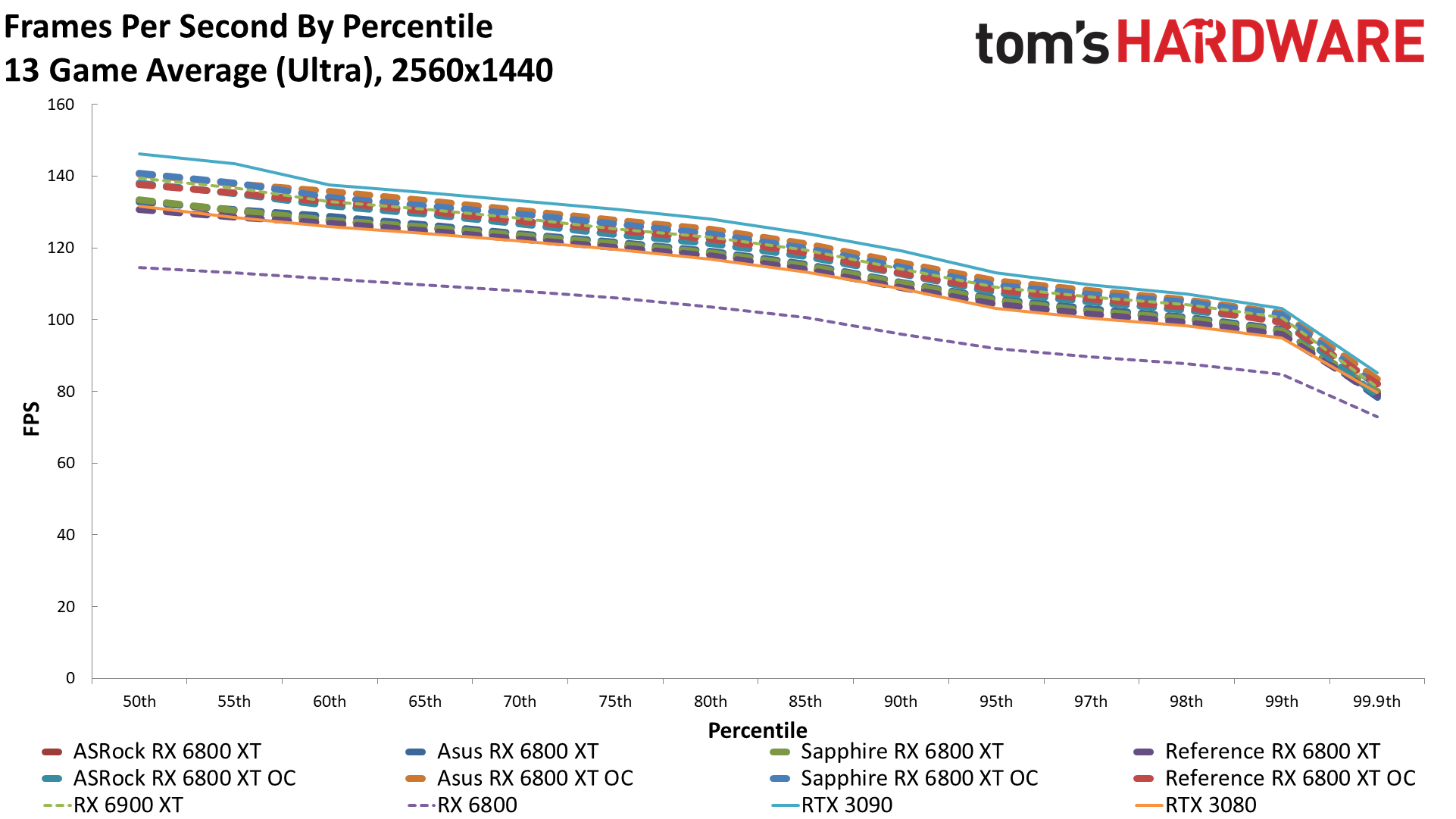
At stock settings, the three custom 6800 XT cards are within 0.2 fps of each other, emphasizing once again how little difference there is among cards with the same GPU. The reference card does fall a bit off the pace, largely because it's using less power we'd wager, though even with our overclocked settings it can't quite close the gap. Interestingly, despite having three 8-pin PEG connectors and a large cooler, the ASRock card doesn't do any better than the Sapphire card — actually, it's a bit worse. It could be the luck of the draw, or just variance between benchmark runs, but our results consistently put the ASRock a bit below the other two AIB cards.
In the larger scheme of things, the overclocked 6800 XT cards continue to basically match the reference 6900 XT. The RTX 3090 starts to pull away from the other GPUs a bit, now that CPU bottlenecks are reduced, while the 6800 XT still leads the RTX 3080. It will be interesting to see what happens if Nvidia actually does release a 20GB 3080 (or 3080 Ti) card in the future, though the pricing on such a GPU would be higher than the current 3080. Well, theoretical 3080 prices, since most cards are selling for quite a bit more than MSRP and supplies are still very limited.
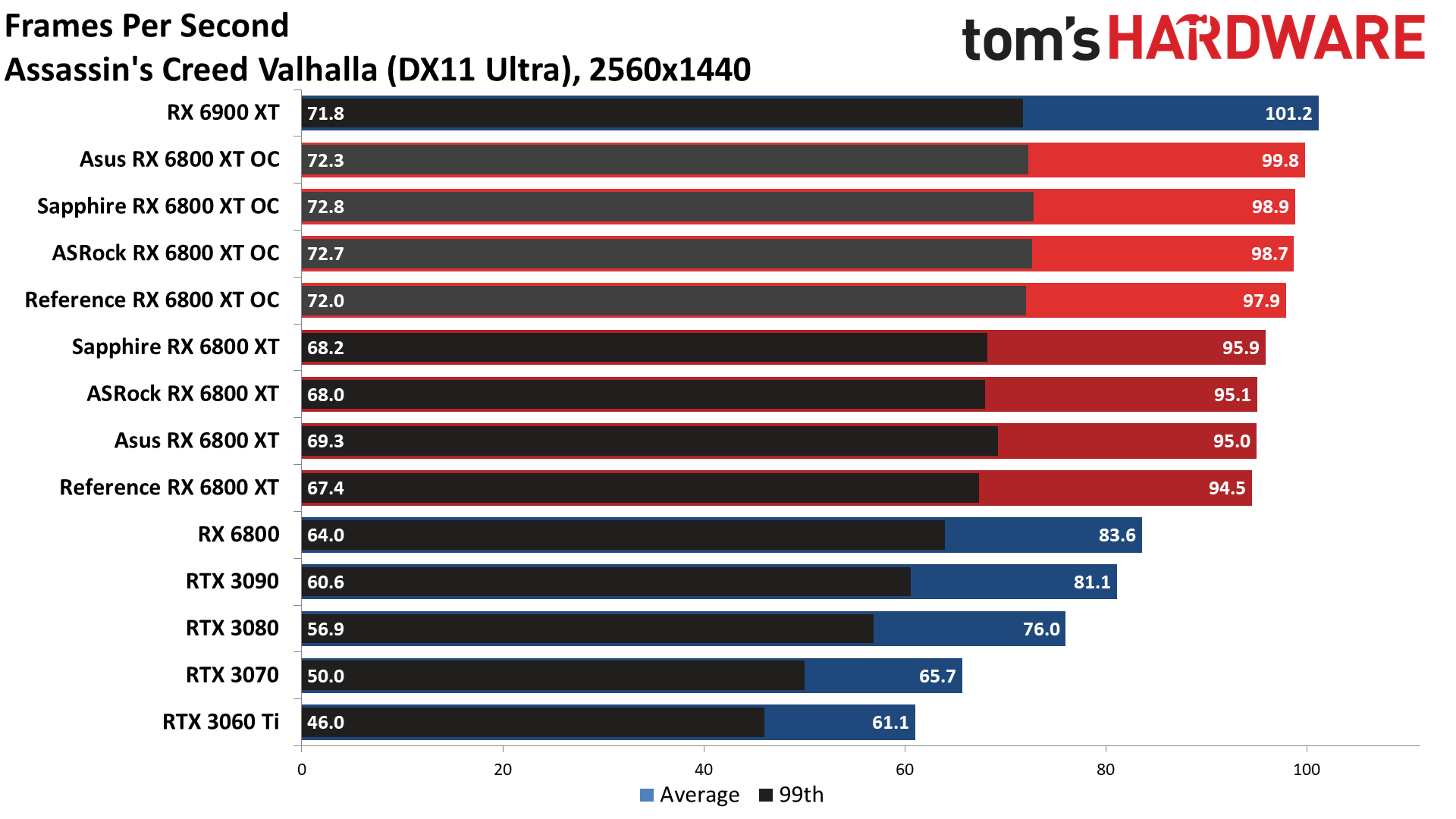
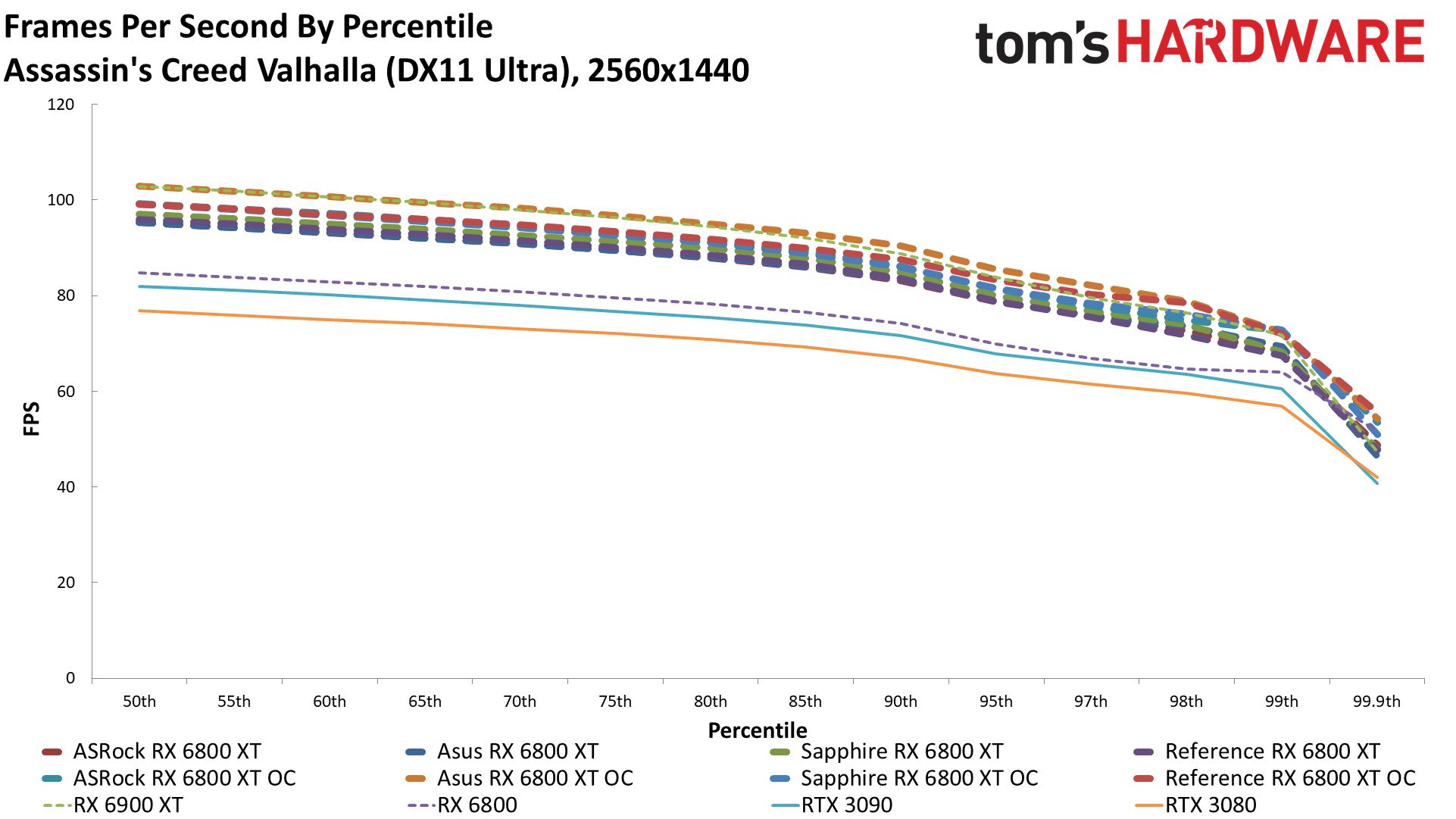
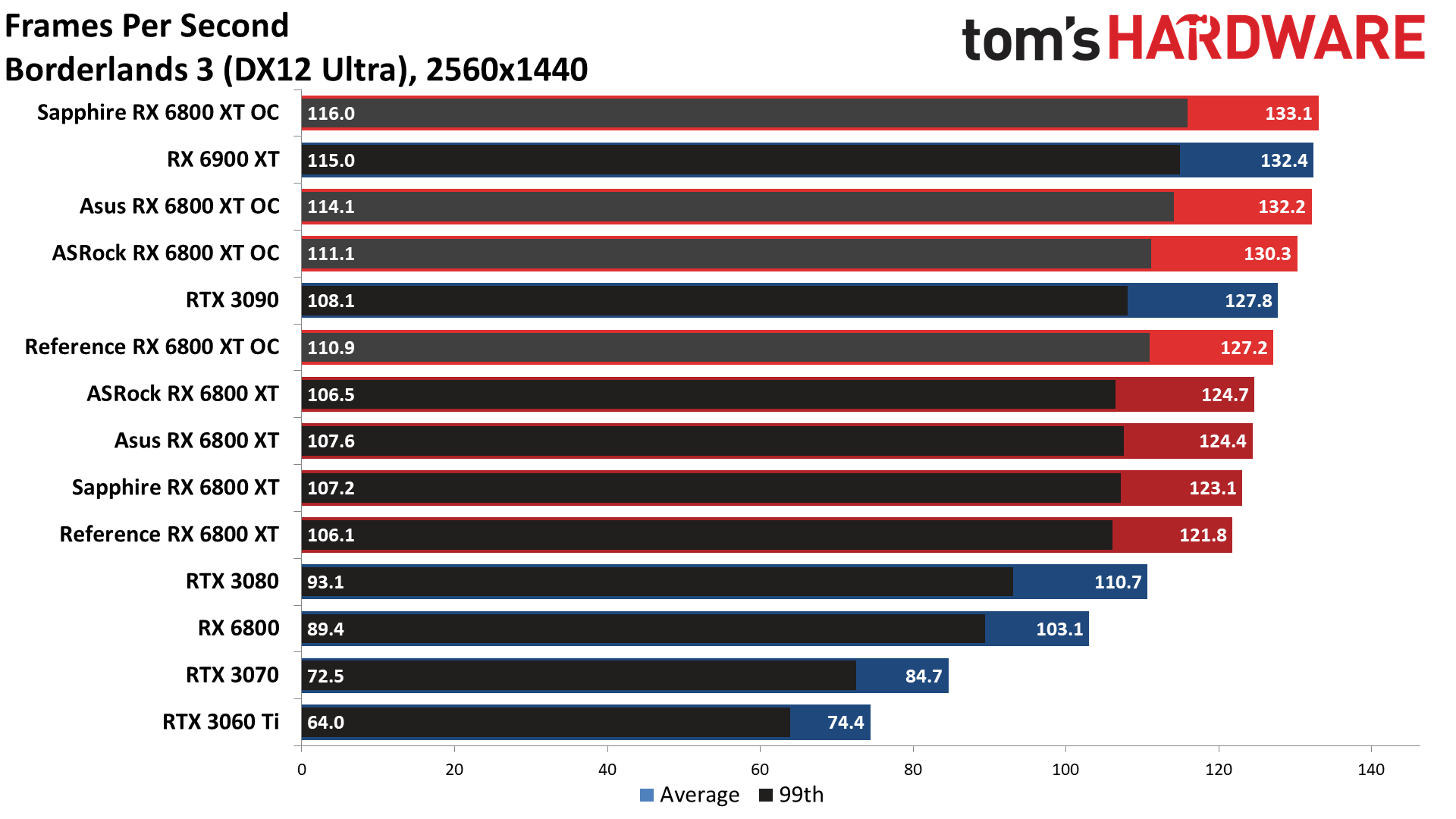
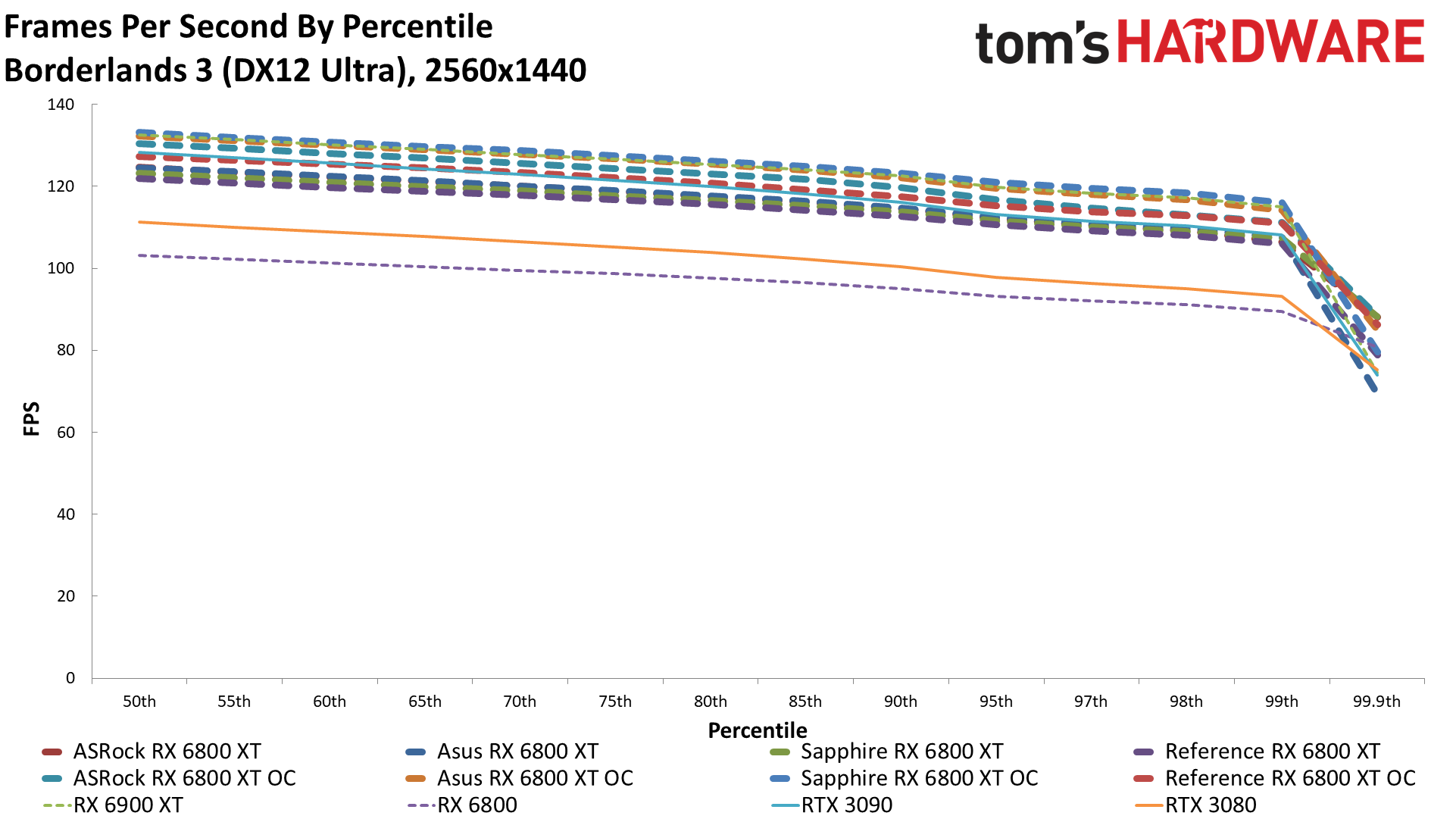
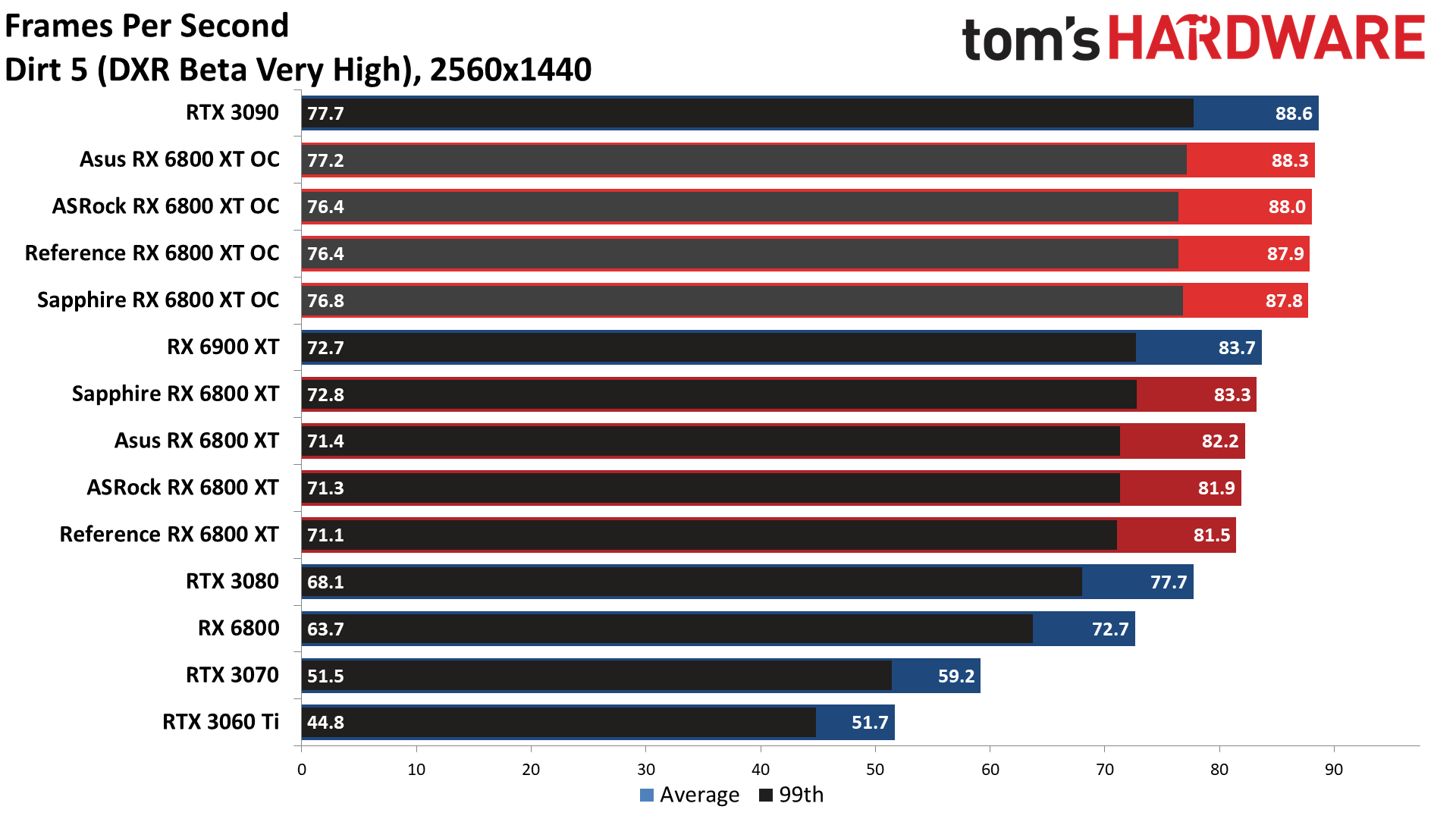
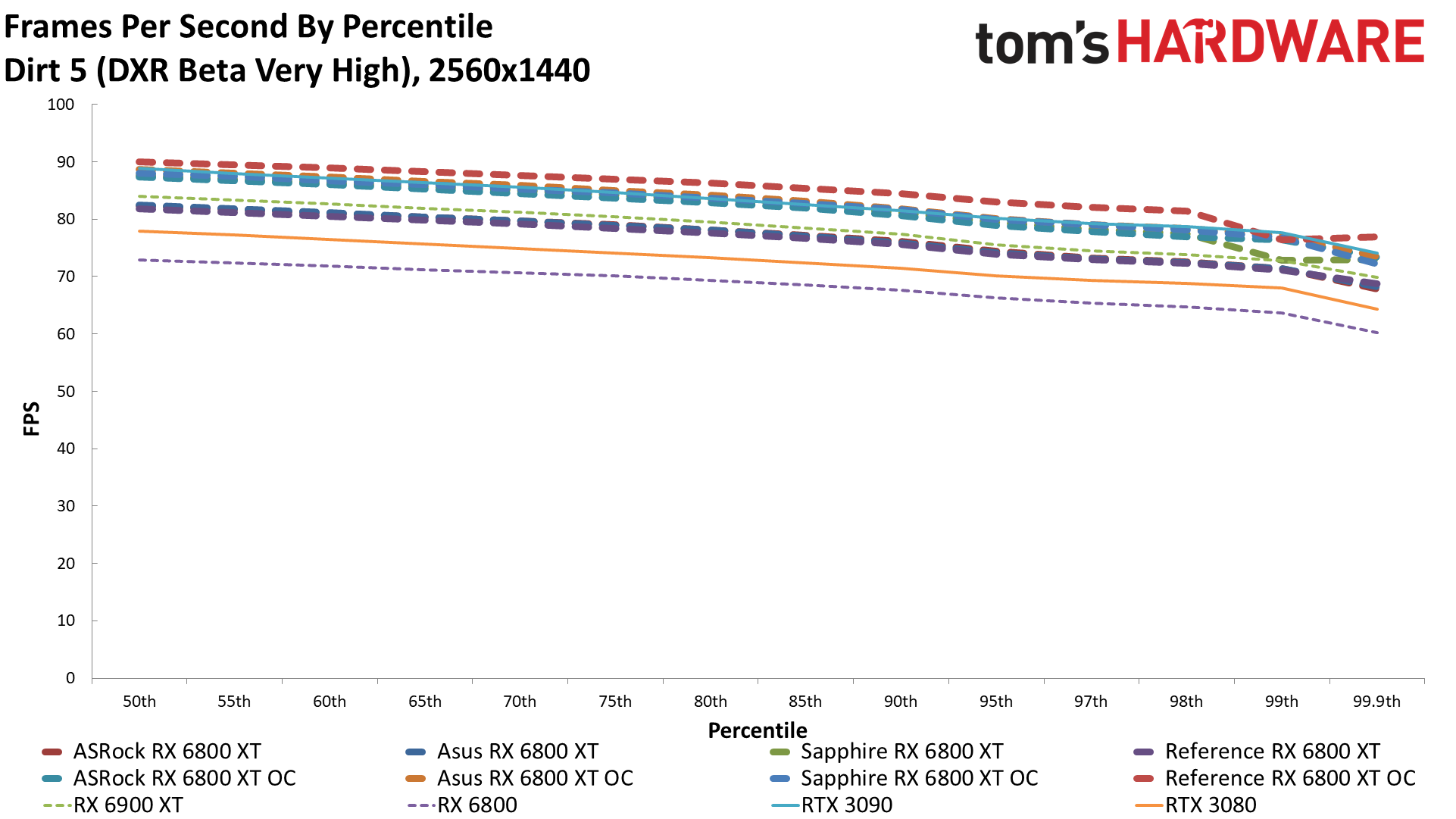
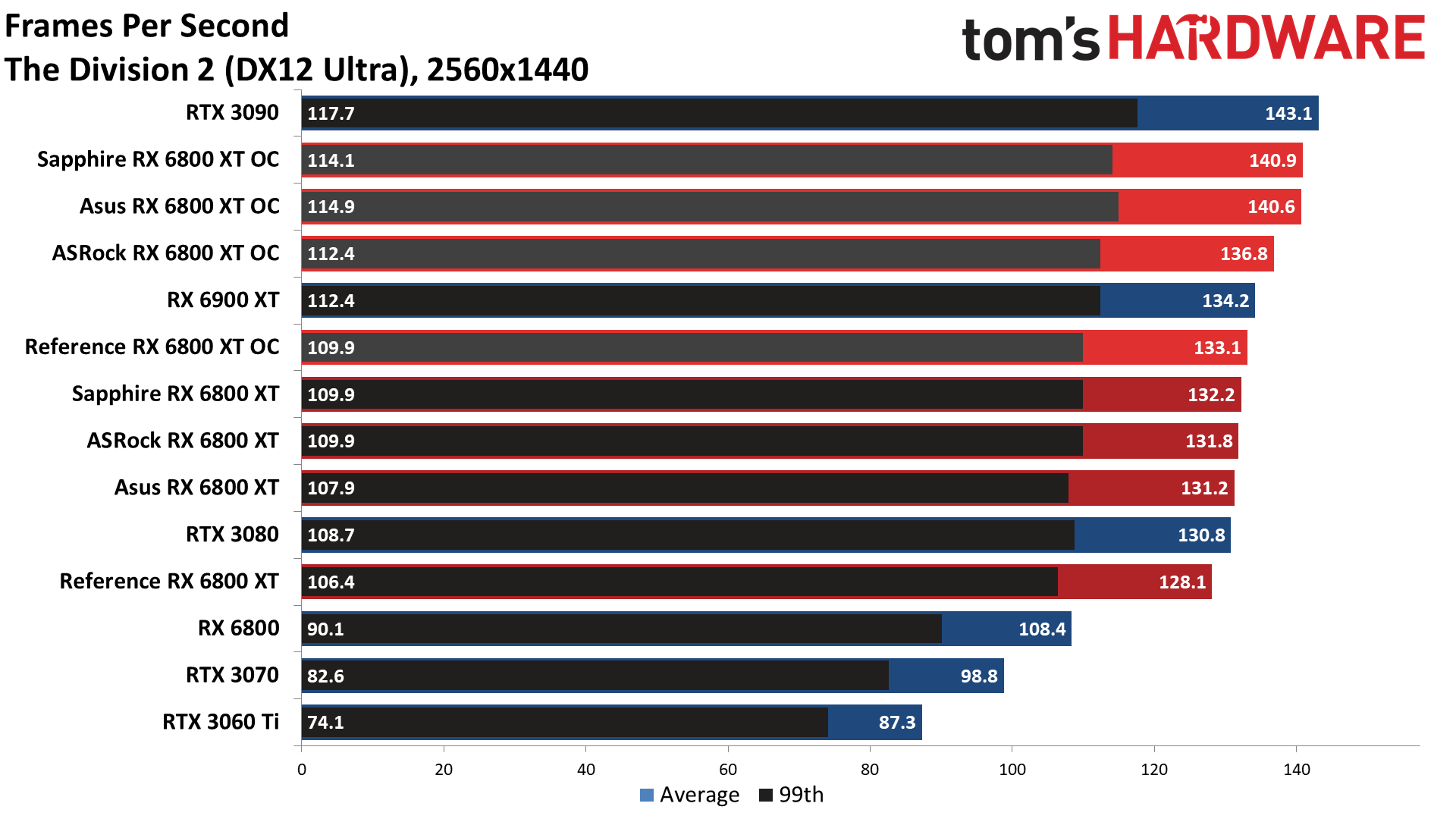
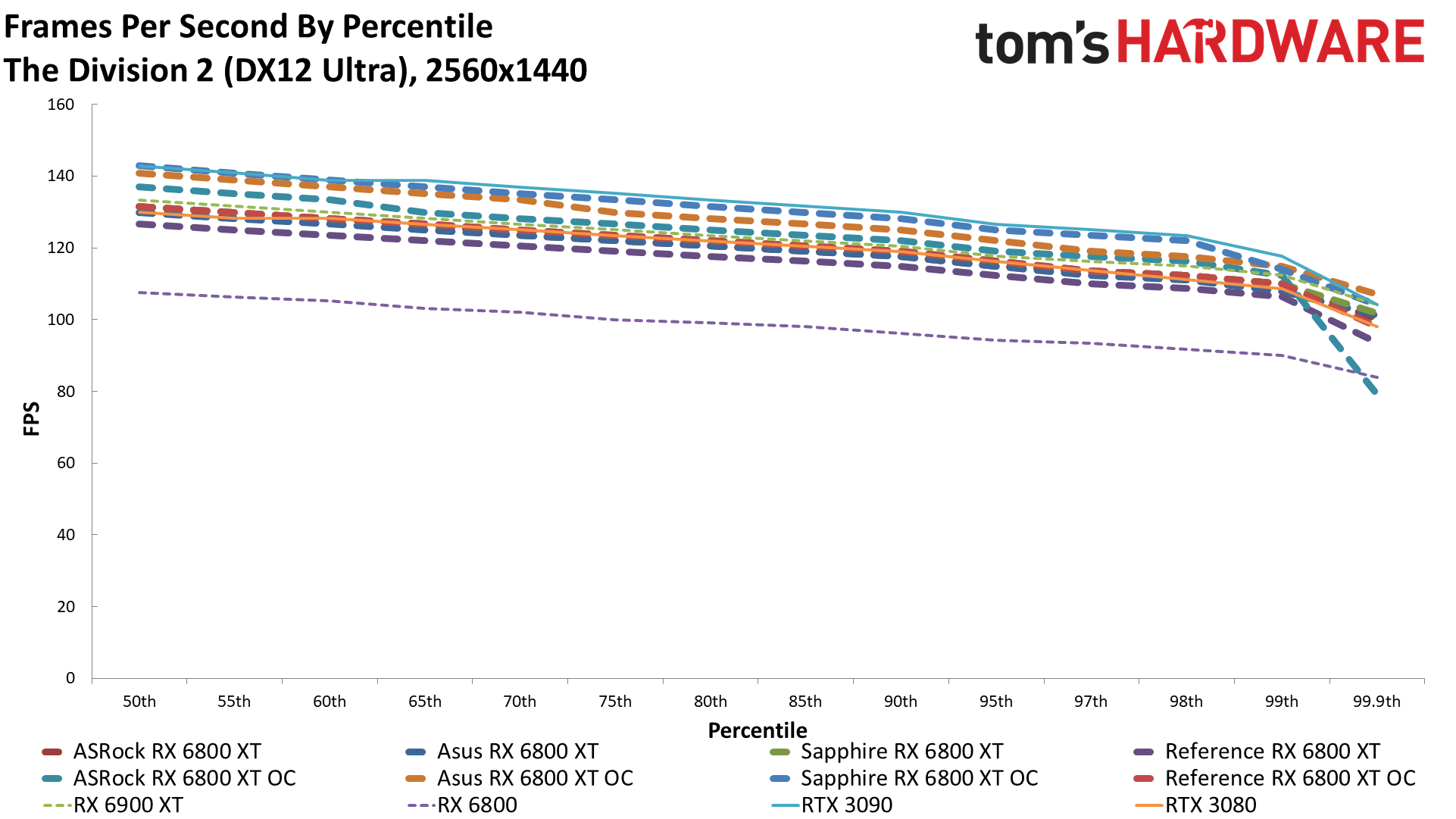
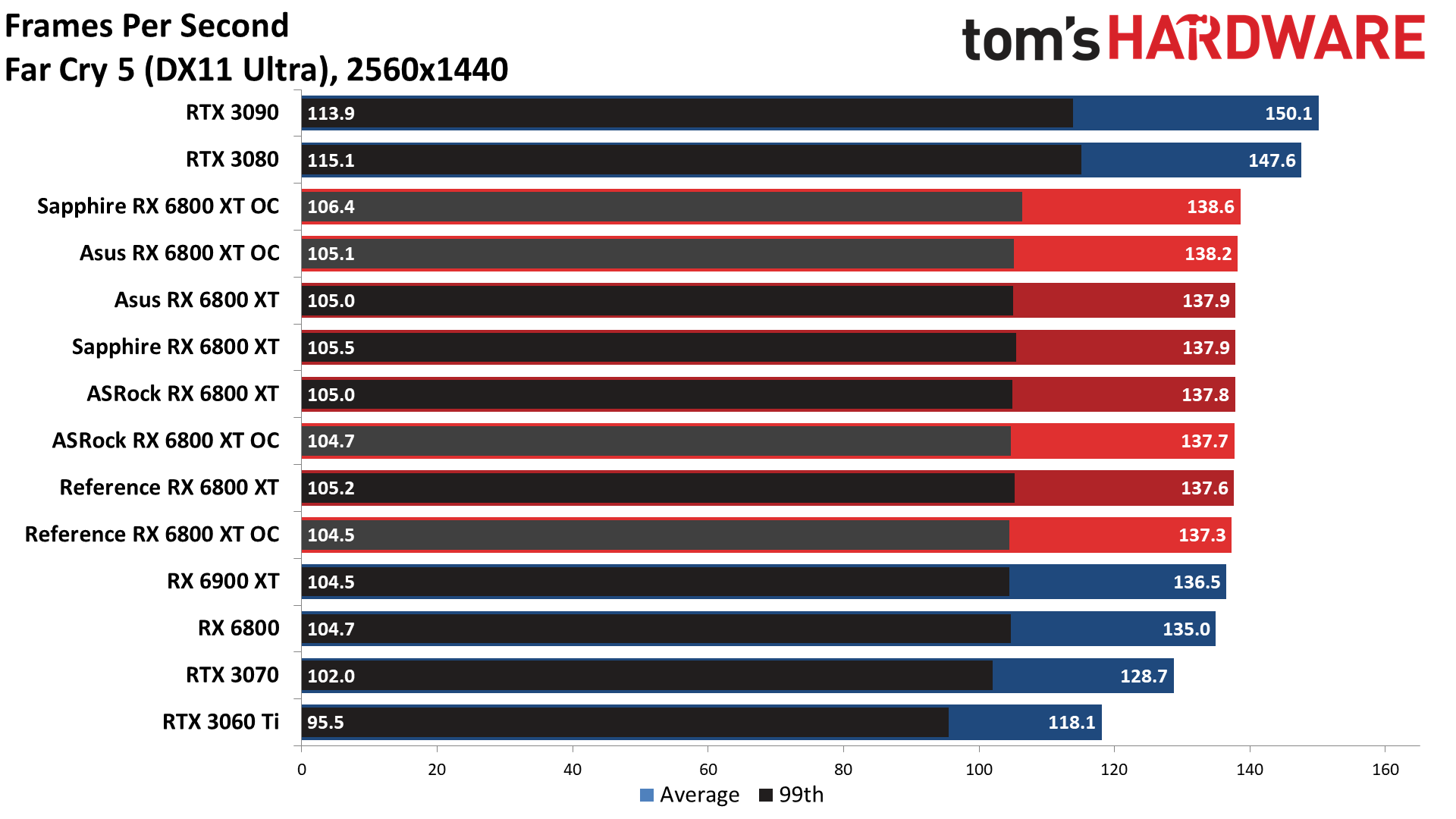
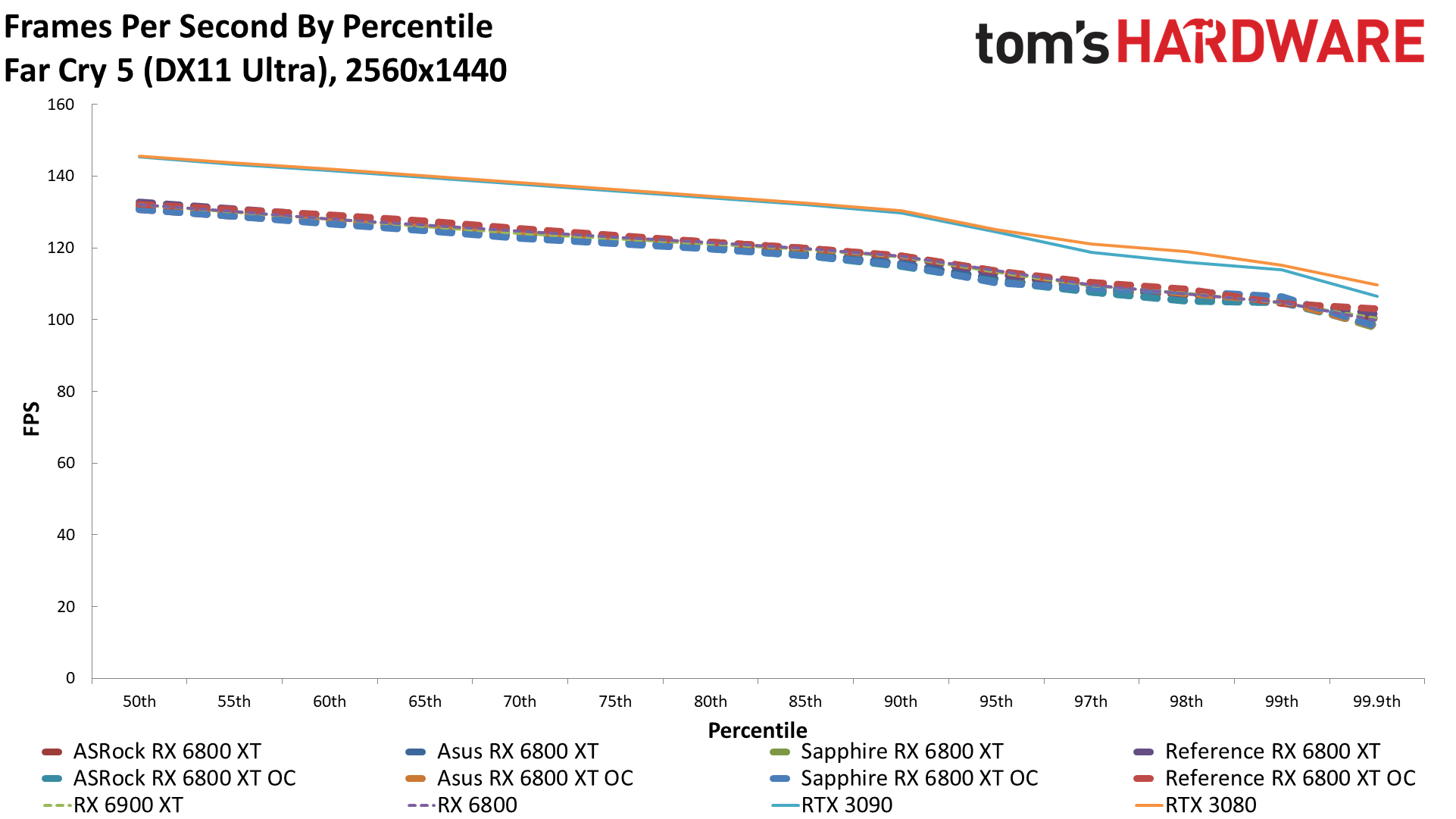
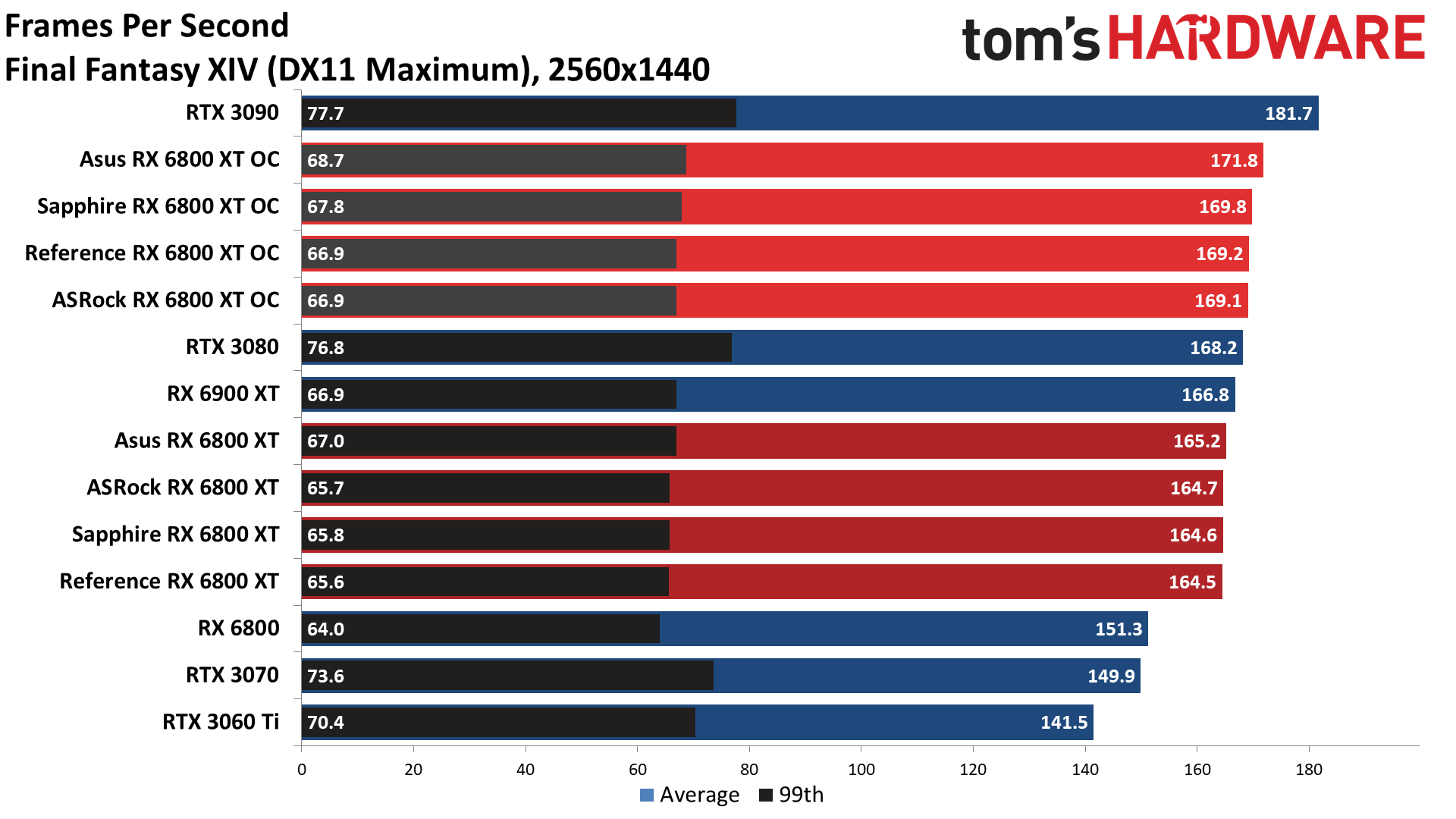


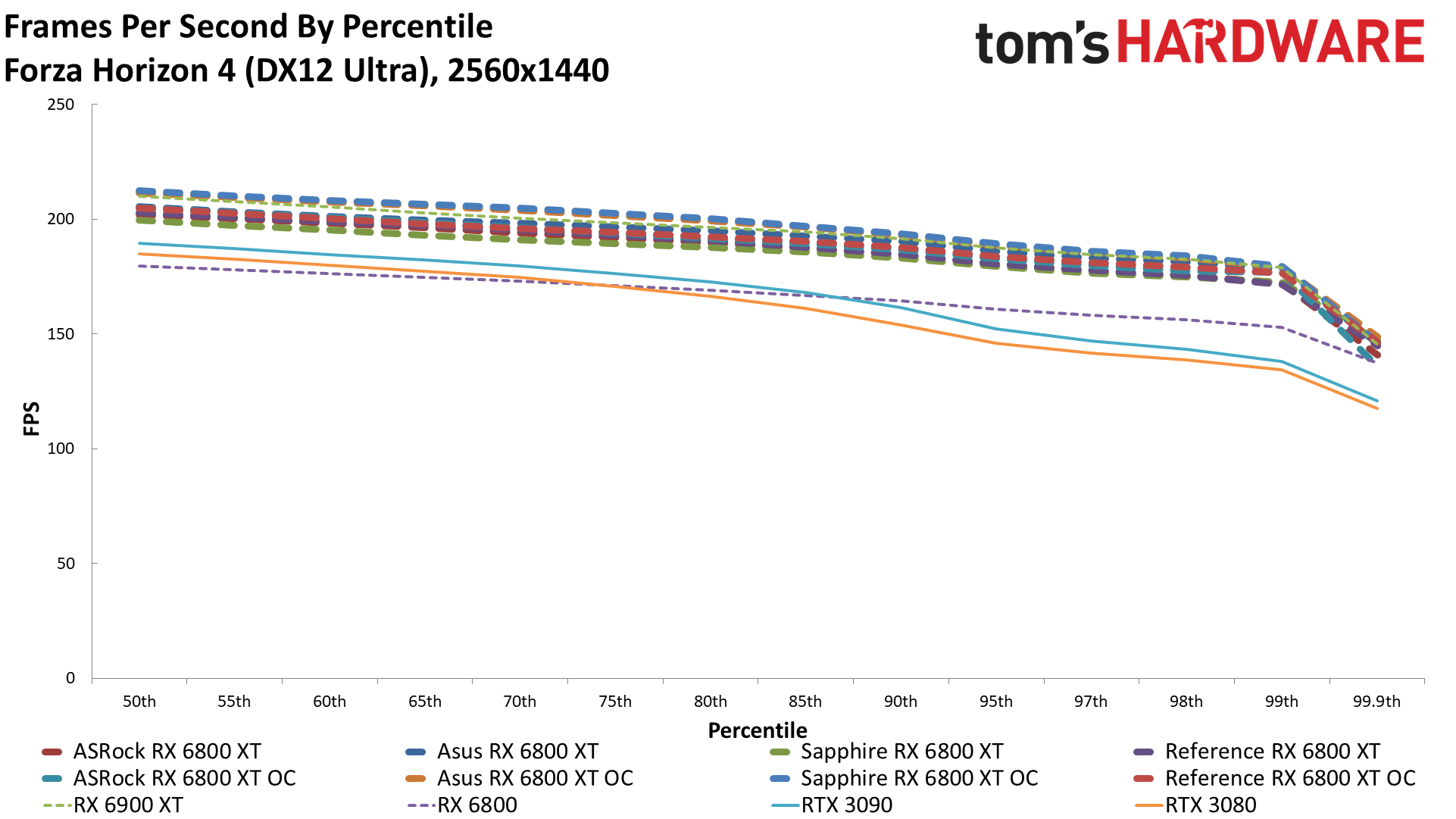

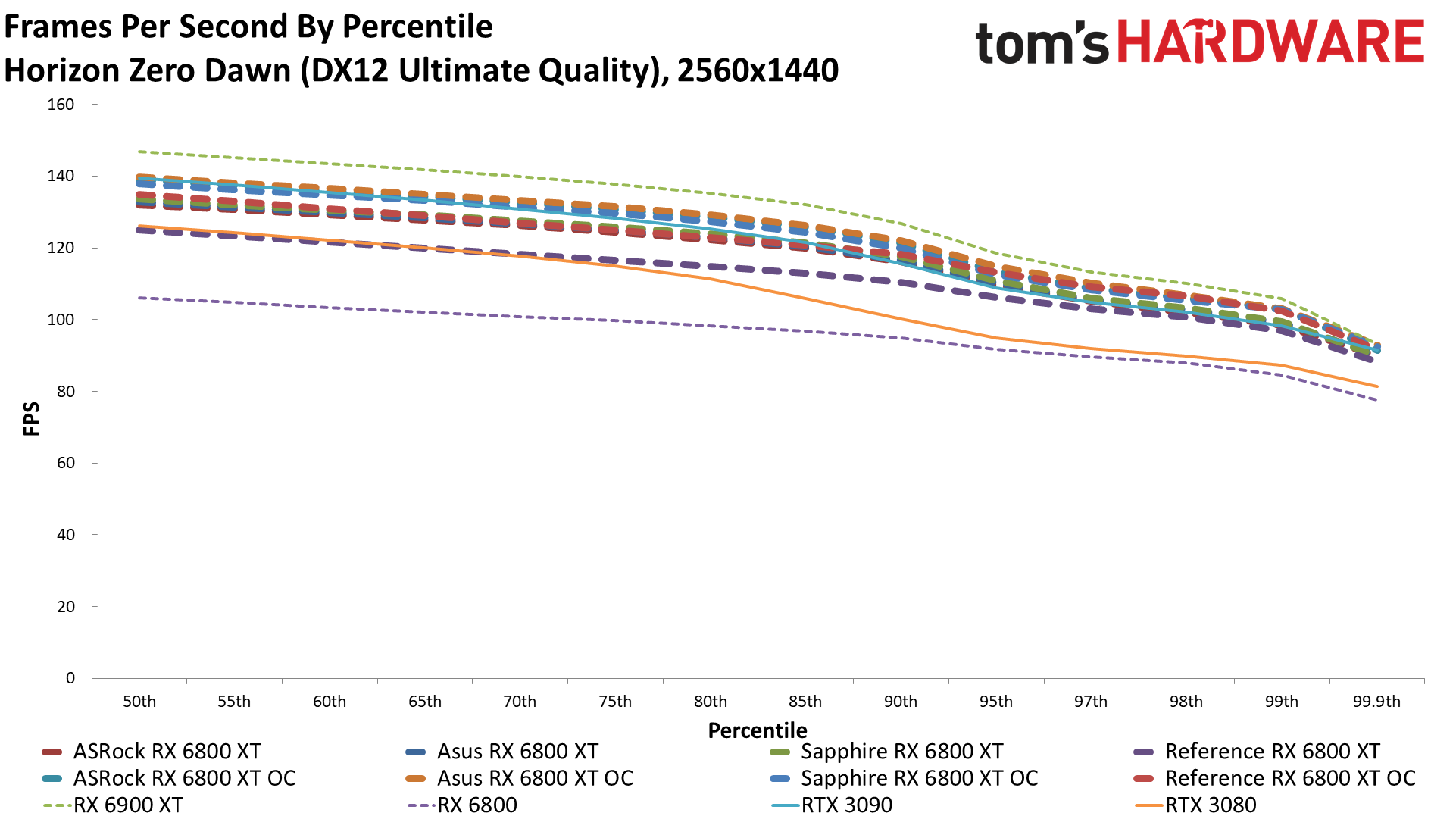
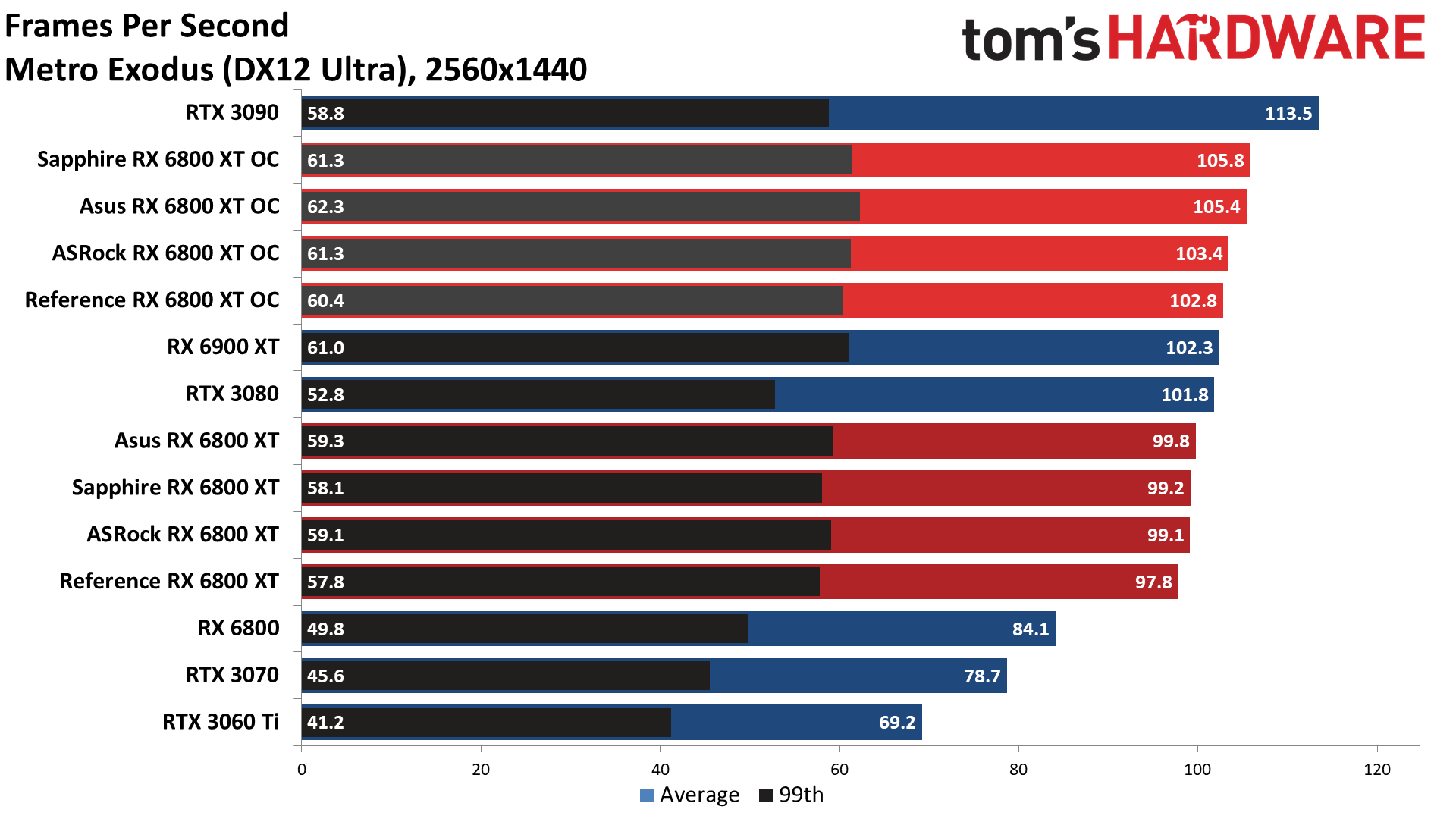


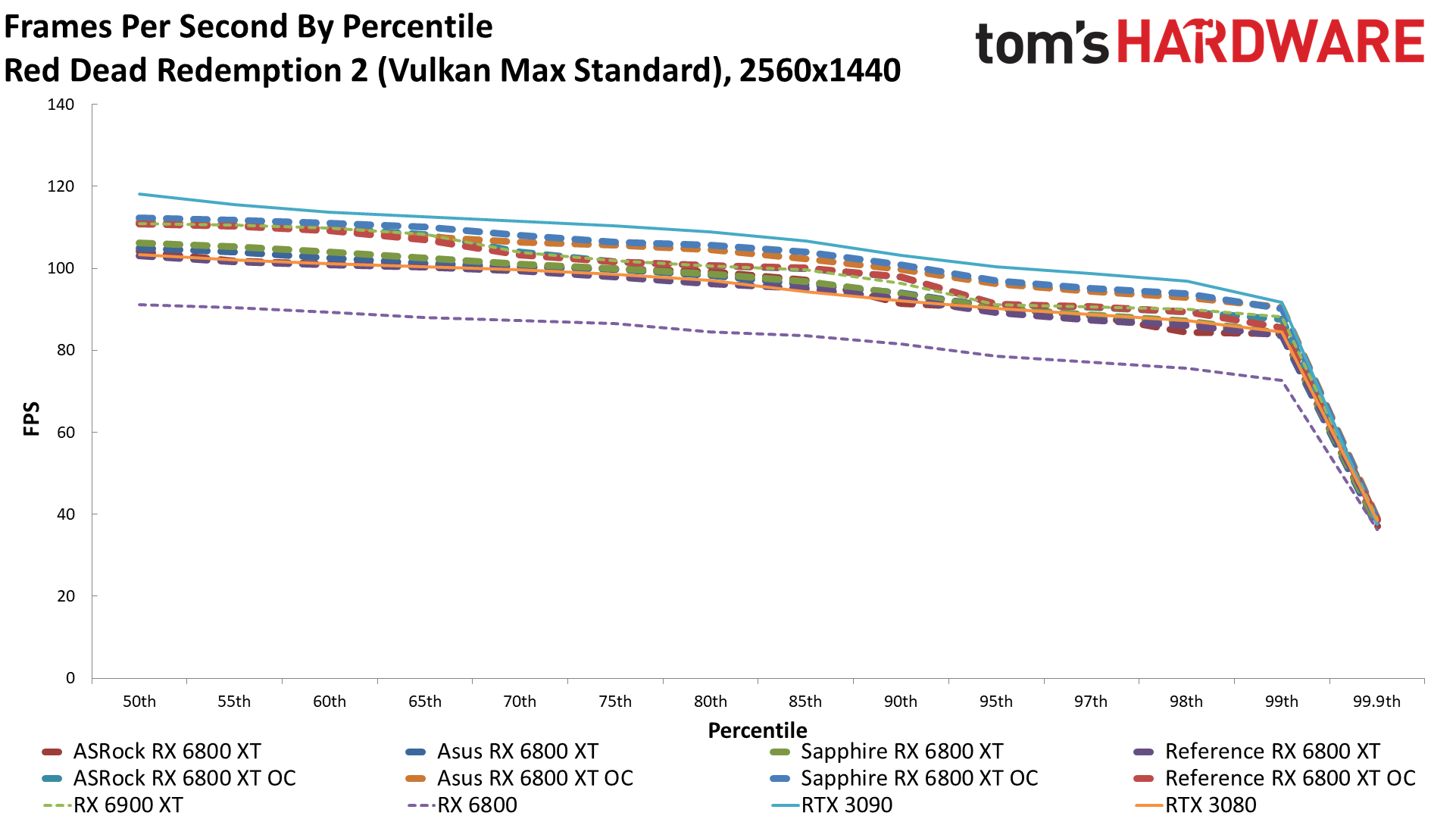



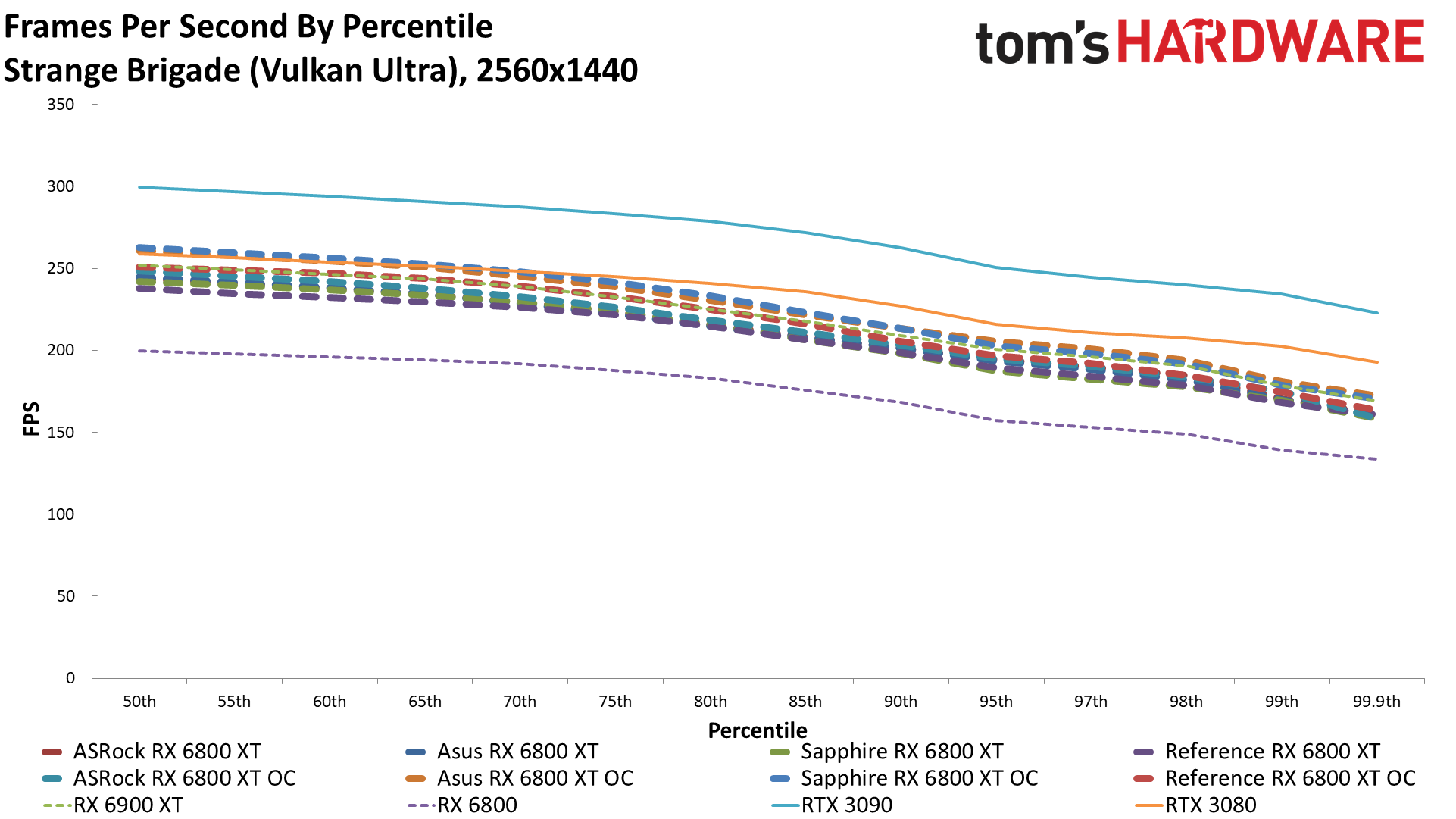


There's a bit more variation in performance this time, but nothing particularly noteworthy. The Sapphire Nitro+ takes the top spot in both stock and overclocked modes in several games, but most of the results are within 1-2 percent of each other at most (among the 6800 XT custom cards).
Looking at frame rates, even at stock clocks all of the games run at well over 60 fps, often into the 100+ fps range. Only a few break 144 fps, but again, that's why G-Sync and FreeSync are useful. There's one exception, naturally: Watch Dogs Legion with ray tracing enabled is a beast to run, as are most DXR games without DLSS. The 6800 XT can only manage high-30s performance, and it's worth mentioning that the DXR reflections on AMD and Nvidia still aren't the same. Check out the extra images in the gallery below to see what we're talking about.

Nvida DXR, note the reflections in the puddle
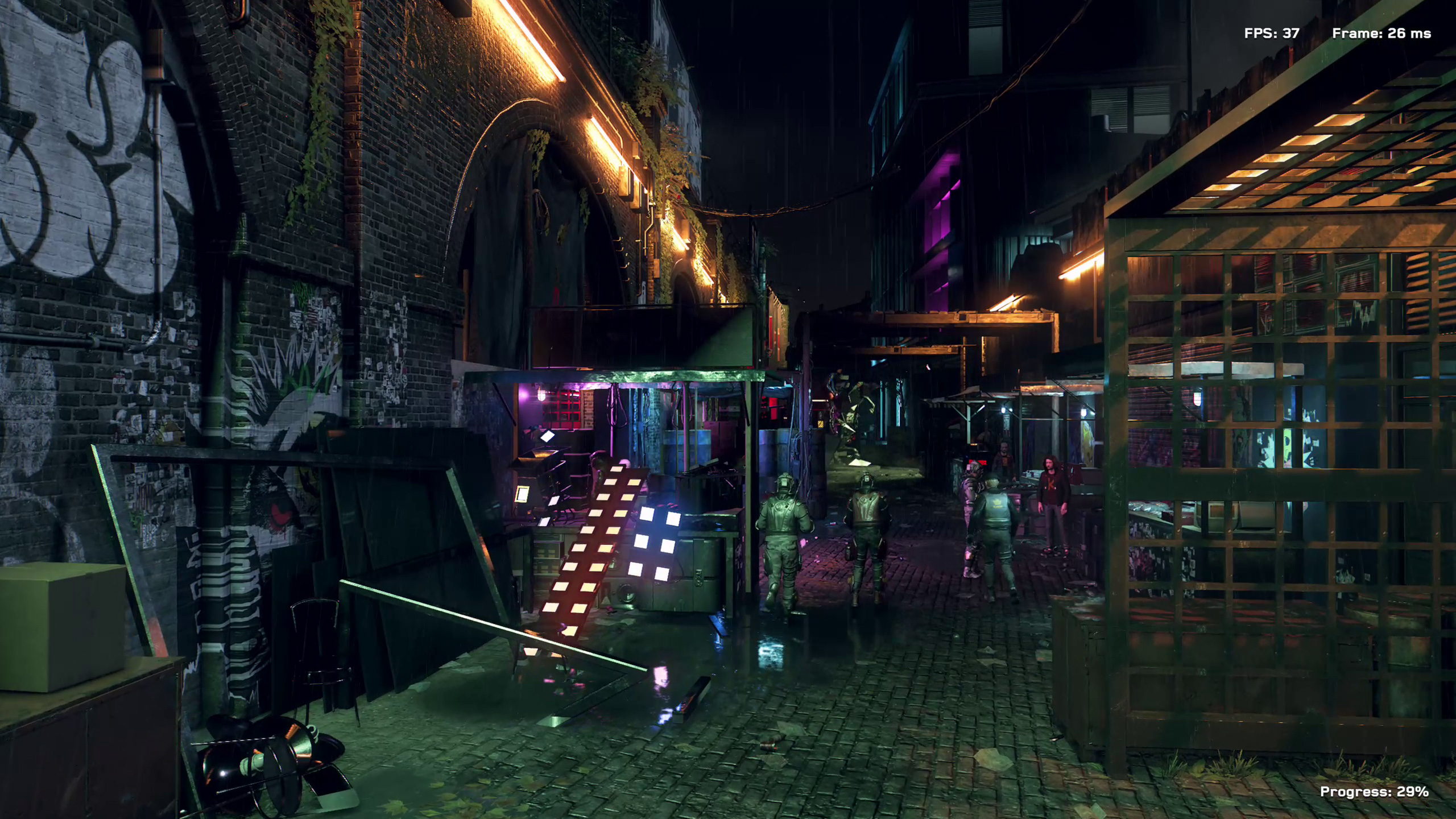
AMD DXR, some of the reflections are missing or muted
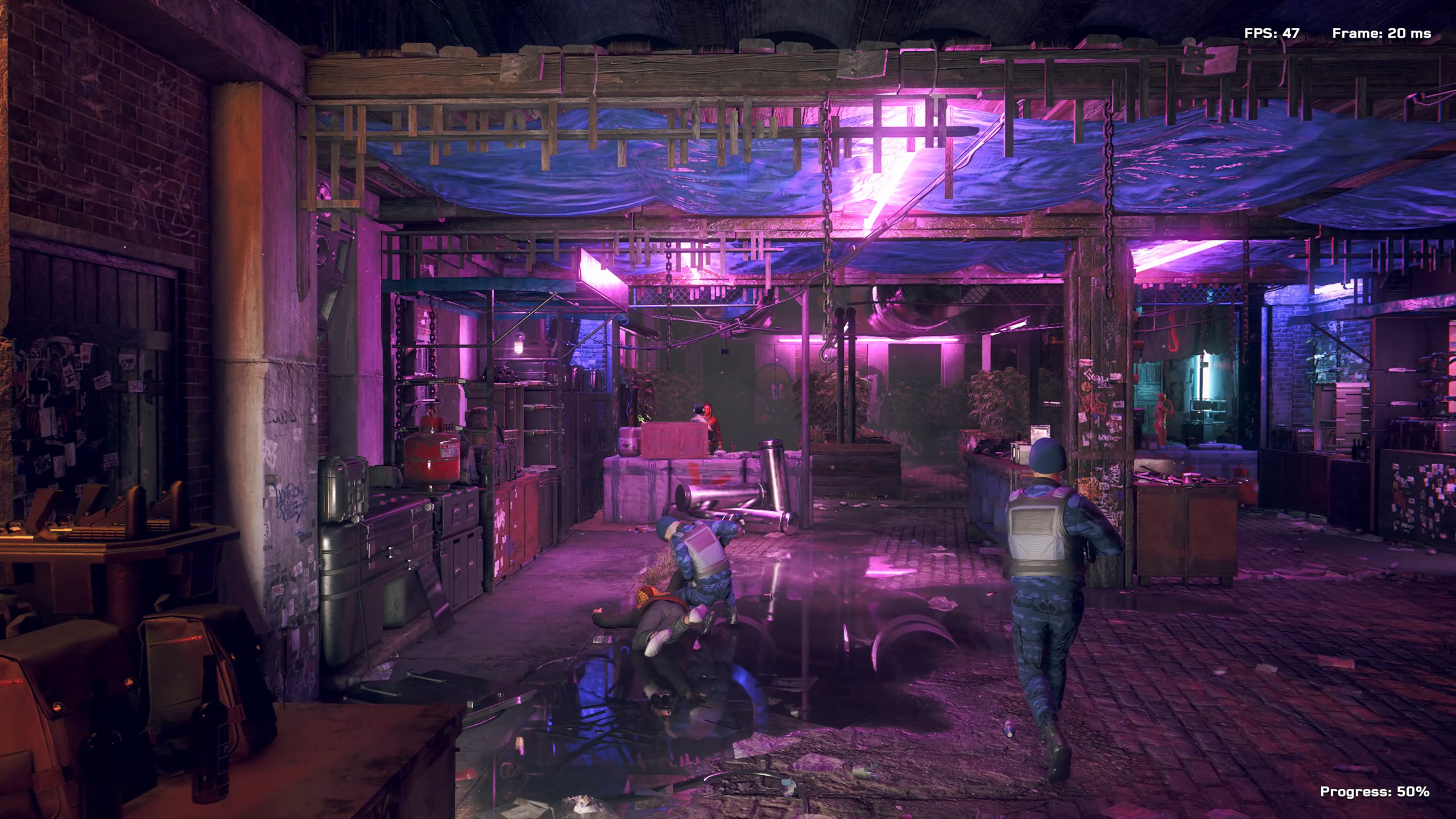
Nvidia DXR: The reflections in this puddle are even more noticeable...
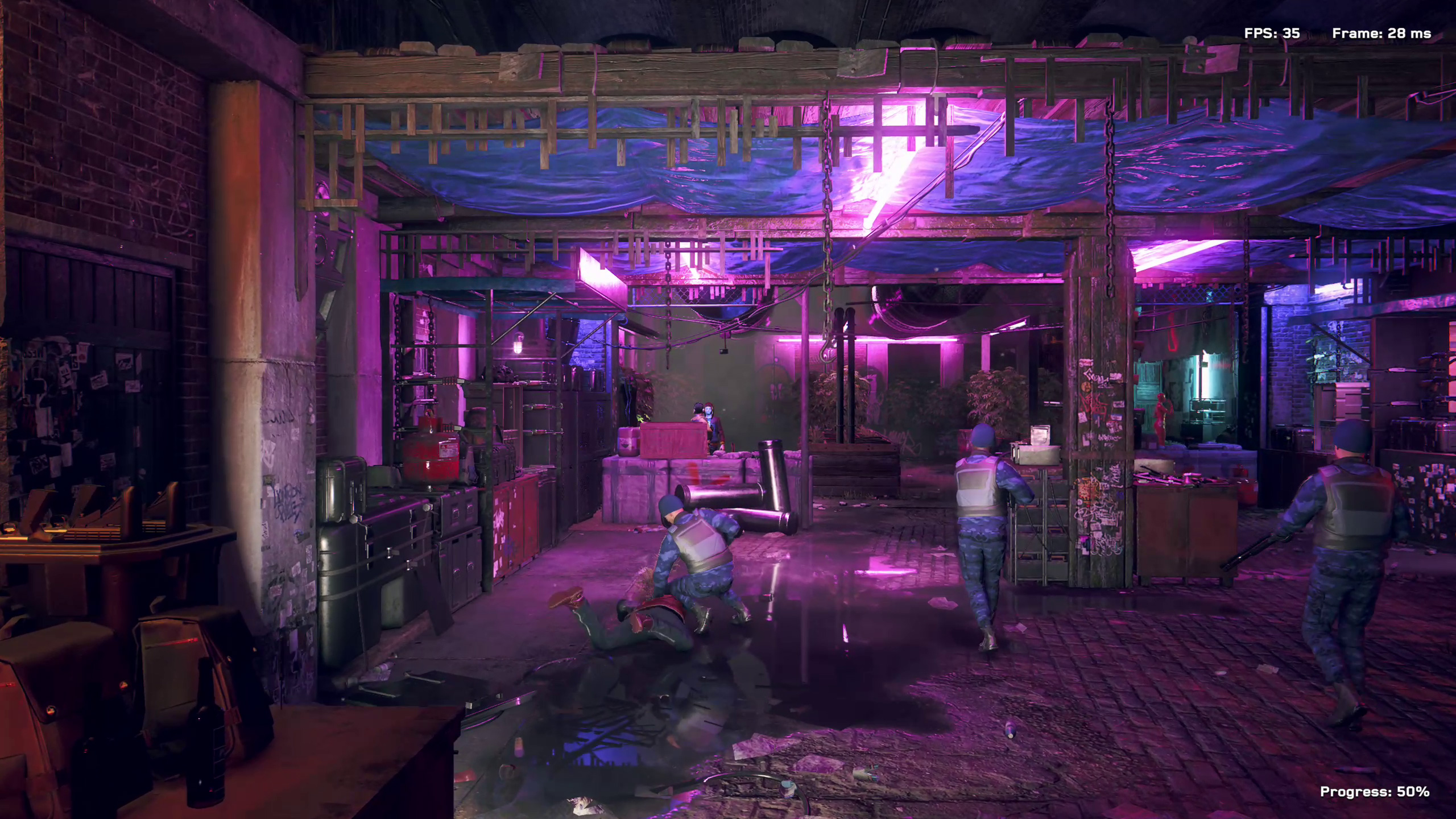
AMD DXR: ...when they're mostly missing!
The above are with the latest patches in place, and we're still getting a lot of differences between AMD and Nvidia DXR (DirectX Raytracing) quality. It's only used for reflections in Watch Dogs Legion, but you can see the differences in puddles, shiny metal surfaces, and various windows. It's as though AMD has greatly reduced the range of testing for ray triangle intersections, which could improve performance but at the cost of image quality.
Whether you want or need ray tracing is debatable, but with consoles now supporting the tech, we expect to see additional DXR games. Will they also support DLSS, or AMD's upcoming FidelityFX Super Resolution? And will they be 'dumbed down' for the console GPUs? Those are good questions, and considering the RX 6800 is faster than the Xbox Series X, we suspect limited RT effects on console games will be more common than more robust implementations like we've seen in Cyberpunk 2077.
Get Tom's Hardware's best news and in-depth reviews, straight to your inbox.
MORE: Best Graphics Cards
MORE: Desktop GPU Performance Hierarchy Table
MORE: All Graphics Content
Current page: Radeon RX 6800 XT Roundup: 1440p Gaming Benchmarks
Prev Page Radeon RX 6800 XT Roundup: 1080p Gaming Benchmarks Next Page Radeon RX 6800 XT Roundup: 4K Gaming Benchmarks
Jarred Walton is a senior editor at Tom's Hardware focusing on everything GPU. He has been working as a tech journalist since 2004, writing for AnandTech, Maximum PC, and PC Gamer. From the first S3 Virge '3D decelerators' to today's GPUs, Jarred keeps up with all the latest graphics trends and is the one to ask about game performance.
-
Makaveli Canadian pricing for these cards. Asrock from newegg.ca and the last two from canada computers.Reply
ASRock Radeon RX 6800 XT Taichi Gaming $1499
SAPPHIRE NITRO+ Radeon RX 6800 XT $1149
ASUS ROG STRIX LC Radeon RX 6800 XT $1299
And for the money Asus is asking for this card, they could have alteast sleeved those fan cables its mess. For $1000+ asking price kinda of a slap in the face. -
Jobeker Your testing methodology is flawed.Reply
The memory should not be overclocked in these cards.
These cards show much better results once you push the GPU to the max & leave the memory at stock.
It seems that you & all the other testers I have come to respect in almost 2 decades of reading tests & benchmarks , have become fixated on maxing the mem to the point of "no crush" without even comparing the results.
I hope you still have at least one of the cards at hand to make 1 more test, you will see that stock mem@2000mhz + GPU@2600mhz gets much better results than mem@2140mhz + GPU@2600mhz .
I am active on a different language forum & a local system builder/fine tuner corroborated these results with several different 6800XT cards.
( he is the one that Identified this issue , I don't own such a card at the moment)
He is now testing a 6900XT .
As a bonus , once you leave the memory at stock you get a few extra watts for higher gpu oc.
I don't care that much about the actual value of the specific cards ( definitely not at current pricing ) it is however very important for me to make sure you testing methodology isn't flawed.
I seriously hope you still have one of the cards for one more test . -
JarredWaltonGPU Reply
Define "much better results" for me, please. The overclocking is not supposed to be the major focus, because silicon lottery and other elements come into play. Frankly, I wouldn't bother overclocking most GPUs -- it's just not enough of a gain to warrant the added power and potential stress on the hardware. Anyway, a 7.5% memory OC isn't much, and neither is the 3-7% increase in performance I measured with the 'max' OC I achieved.Jobeker said:Your testing methodology is flawed.
The memory should not be overclocked in these cards.
These cards show much better results once you push the GPU to the max & leave the memory at stock.
It seems that you & all the other testers I have come to respect in almost 2 decades of reading tests & benchmarks , have become fixated on maxing the mem to the point of "no crush" without even comparing the results.
I hope you still have at least one of the cards at hand to make 1 more test, you will see that stock mem@2000mhz + GPU@2600mhz gets much better results than mem@2140mhz + GPU@2600mhz .
I am active on a different language forum & a local system builder/fine tuner corroborated these results with several different 6800XT cards.
( he is the one that Identified this issue , I don't own such a card at the moment)
He is now testing a 6900XT .
As a bonus , once you leave the memory at stock you get a few extra watts for higher gpu oc.
I don't care that much about the actual value of the specific cards ( definitely not at current pricing ) it is however very important for me to make sure you testing methodology isn't flawed.
I seriously hope you still have one of the cards for one more test .
Dropping the memory OC and trying for a slightly higher core OC is totally within the parameters of what can be done, and may improve performance more than what I've shown. More effort on tuning voltages, fan speeds, etc. could also improve performance. Without physically modding the cards, though, I strongly doubt you'll see more than a 5% improvement over what I achieved, which is a 10% potential total improvement. In practice, I'm sure it would be far less than that -- probably only a 1-2% difference from my max core + max RAM OC results. And there's a very good chance that, despite what you're positing, overclocking the memory actually does improve performance.
Let me give you just one example, because based on this I see no reason to bother retesting anything more.
SettingAsus Strix LC RX 6800 XT OCAsus Strix LC RX 6800 XT OC StockRAMAsus Strix LC RX 6800 XTMetro Exodus1080p Ultra125.09123.2119.46
1440p Ultra105.43103.6999.77
4k Ultra69.4468.5264.81
So, in at least one game, using the same card in all three cases (the Asus Strix LC), dropping the RAM OC but leaving the GPU at the same 2600 MHz setting reduced performance by 1-2%. So much for my "flawed" methodology. -
shady_021 The only thing I see here is all 6800 XT are equal or slightly ahead of a 6900 XT... so except for the price difference what's the point of having a 6900XT?Reply -
JarredWaltonGPU Reply
The overclocked RX 6800 XT cards match the stock RX 6900 XT. If I overclocked the 6900 XT as well, it comes out a bit ahead again.shady_021 said:The only thing I see here is all 6800 XT are equal or slightly ahead of a 6900 XT... so except for the price difference what's the point of having a 6900XT?
This is something I pointed out in the RX 6900 XT review: it has identical clocks, TDP, and VRAM, so the only difference is 80 CUs instead of 72 CUs. That means at most an 11% advantage for the 6900 XT, but because of VRAM being the same it is usually more like 4-5%. So it's not really worth the extra $350, except none of the 6800 XT cards cost $649, and none of the 6900 XT cards cost $999 -- and in fact, neither of those really exists in any meaningful quantity AFAICT. Tens of thousands of cards worldwide perhaps, but that's a drop in the proverbial bucket. -
Jobeker JarredWaltonGPU , Thank you for taking interest in my comment & performing the relevant tests.Reply
I've ( we actually ) been fed with a lot of information in the past 2 weeks that led me to believe the claim I made .
I apologize that it came out rude.
I trust your findings better .
Thank you. -
HC1Gunner Reply
Question, how is this a round up, when other manufactures like Gigabyte weren't included?Admin said:We've rounded up multiple Radeon RX 6800 XT cards to see how the various models stack up. Higher factory overclocks, liquid cooling hybrids, massive coolers, and increased pricing are the general trend while GPUs continue to be in short supply.
AMD Radeon RX 6800 XT Roundup: ASRock, Asus, and Sapphire Reviewed : Read more
Kind of stupid to do these reviews, when you can't find any of these cards for retail sale. -
pbergonzi Reply
Thank you for your thoughtful testing and article.Admin said:We've rounded up multiple Radeon RX 6800 XT cards to see how the various models stack up. Higher factory overclocks, liquid cooling hybrids, massive coolers, and increased pricing are the general trend while GPUs continue to be in short supply.
AMD Radeon RX 6800 XT Roundup: ASRock, Asus, and Sapphire Reviewed : Read more -
JarredWaltonGPU Reply
A roundup isn't every card or manufacturer possible; it's a roundup of the cards we were sent. So rather than three individual 6800 XT reviews, you get a roundup of three cards plus the reference model.HC1Gunner said:Question, how is this a round up, when other manufactures like Gigabyte weren't included?
Kind of stupid to do these reviews, when you can't find any of these cards for retail sale.